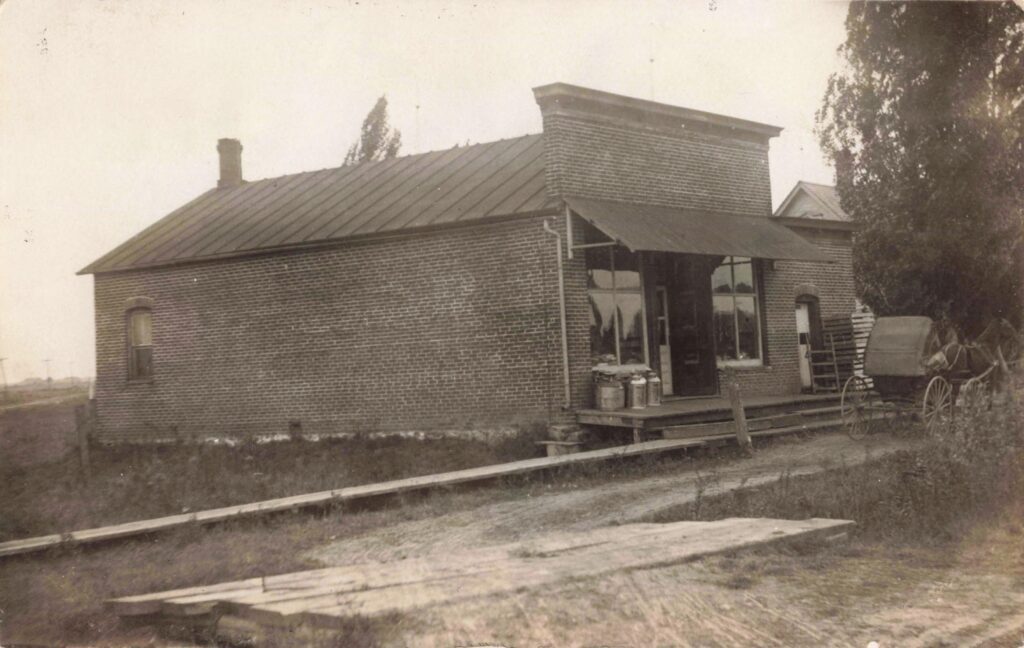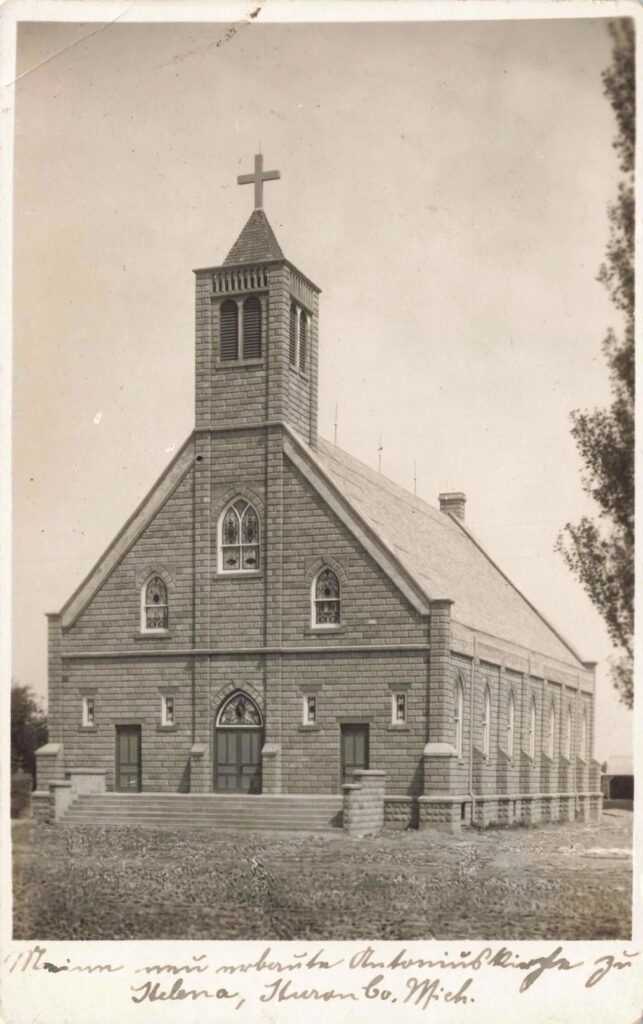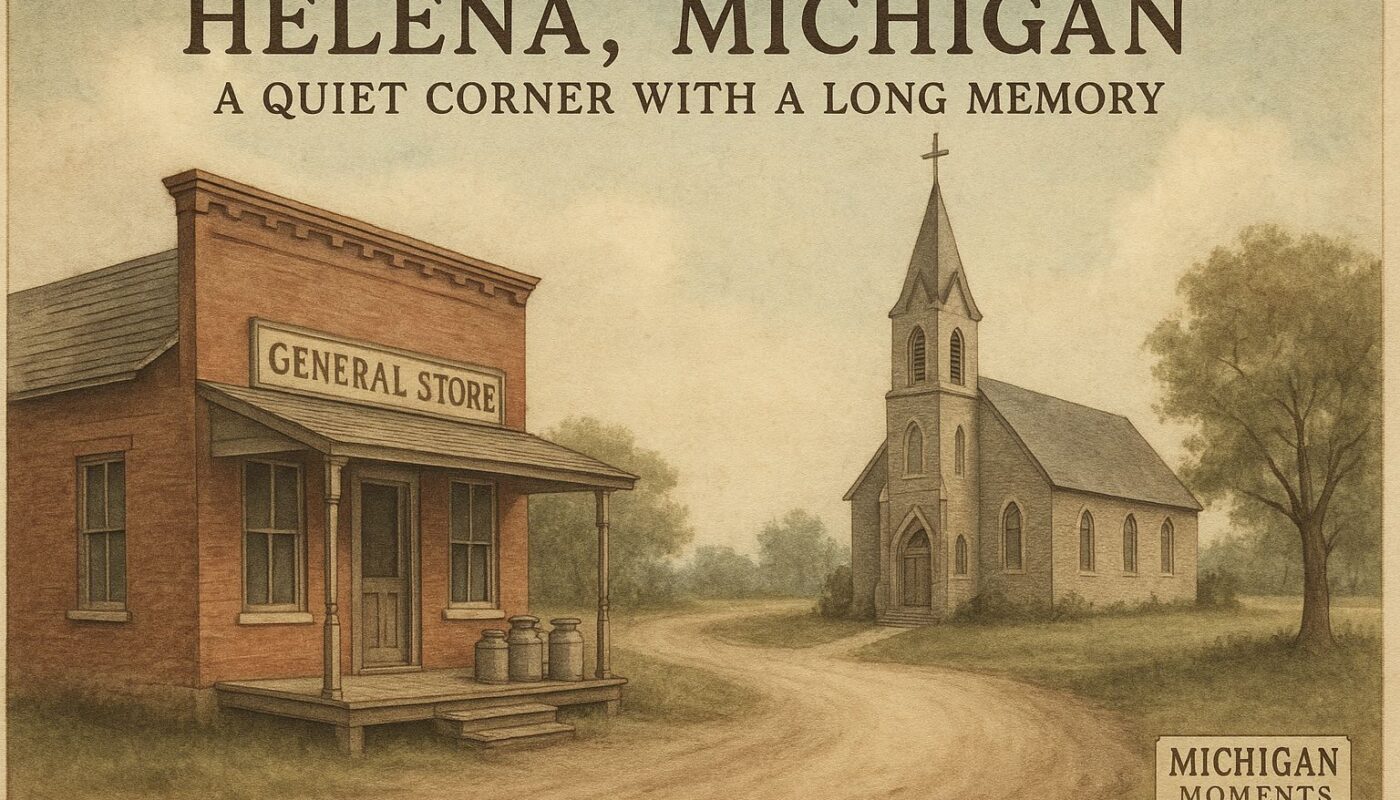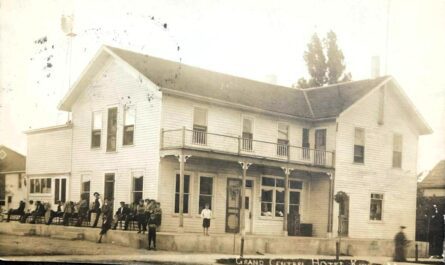
The history of Helena Michigan is easy to overlook—because most maps don’t show the town at all. But if you head a few miles south of Harbor Beach in Michigan’s Thumb, you’ll find what’s left of it: a quiet rural crossroad with a single church still standing. Over a century ago, Helena was a busy farming stop with its own railroad depot, general store, post office, and a hand-built Catholic church. Farmers hauled milk in cans to the store porch. Children walked dirt roads to Mass. It was never a large town, but for the people who lived and worked here, Helena was the center of daily life.
History of Helena Michigan – Table of Contents
The Railroad Gave Rise to Helena
The Port Huron & North Western Railway (later part of the Flint & Pere Marquette Railroad) built a branch through Sherman Township, and Helena became one of its station stops. An 1895 shippers’ guide notes that Helena had a railroad station, a post office, and an express office at that time, indicating its role as a minor trading and shipping point for the surrounding farms.

LR 254: Nessen Lumber Co. — Glen Arbor, MI – Porter engine (maybe ex PH&NW); C no. 329. – University of Michigan
The settlement of the area had begun a few decades earlier. Huron County’s interior was opened to farming after the dense forests were logged and catastrophic wildfires (1871 and 1881) cleared much of the land. Immigrant families of German and Polish origin moved into Sherman Township in the 1860s–1880s, establishing farms and small villages. (For example, the nearby town of Ruth to the southwest was founded by German Catholic settlers in the 1850s.) Helena itself likely takes its name from a person – local lore suggests it may have been named for a woman in an early settler’s family or a railroad official’s wife. However, definitive records of the naming are scarce. By the 1890s, Helena was on the map as a modest village centered on the rail depot at the crossing of Helena Road and the tracks.
Video – Helena Michigan History – How One Church Survived When Everything Else Disappeared
The Helena General Store

Like many rural villages, Helena’s focal point was its general store. The first store likely started in the 1880s, coinciding with the railroad’s arrival. An 1890 county atlas lists a particular George Horton as a “dealer in [goods]” at Helena who also served as the Flint & Pere Marquette Railroad ticket agent. This suggests that Mr. Horton’s establishment functioned as both the local store and the railroad depot office, shared in small towns where the station agent might sell supplies or act as postmaster. Indeed, it was typical for early Helena’s post office to be located in the general store. The store would have supplied groceries, hardware, and animal feed, and acted as an informal meeting place for farmers in the area.
Helena’s post office operated from 1887 until 1906, when Rural Free Delivery (RFD) service reached the area and made local mail pickup points obsolete. After the post office closed, residents received mail via rural routes from larger towns. In 1912, a new chapter began for the Helena Store: George Groll, a resident, built a substantial brick general store just west of the old post office site.
The photo postcard above shows this “Helena Store”, a one-story brick commercial building with a covered front porch. On the porch, milk cans are visible, indicating that the store also served as a collection point for farmers to ship cream or milk to distant dairies. A horse-drawn wagon in the yard underscores that this was the pre-automobile era (likely 1910s), when area farmers still brought their produce to market by horse and wagon.
George Groll’s store became the main general store in Helena, catering to the needs of the farming community through the first half of the 20th century. It was a typical country emporium where locals could buy staples, gossip with neighbors, and even hear the latest news (perhaps the store had a telephone or telegraph connection).
Over time, as the population declined and transportation improved, the little store saw less trade. By the mid- to late 20th century, the Helena Store had closed, and ultimately the building was removed – local church records note that the old store property became part of the St. Anthony’s church parking lot by the 1980s. Today, no commercial businesses remain in Helena; it is essentially a crossroads with a few homes and the church. Yet the memory of the Helena Store lives on in photographs and the stories passed down by Huron County old-timers.
St. Anthony’s Catholic Church (“Antoniuskirche”)

The most significant historic landmark in Helena is St. Anthony of Padua Catholic Church, which was founded in 1910 to serve the local farming families. Prior to having their own church, Catholic residents of Helena likely traveled to nearby parishes – German Catholics to SS. Peter & Paul in Ruth (4 miles away) or Polish Catholics to St. Mary’s in Parisville, for example. Around 1909, the Helena area families petitioned the Diocese of Detroit for a new parish closer to home. Community leader Mr. Kranz gathered a petition with about 70 families requesting a church in Helena. Detroit’s Bishop John Foley approved, and in July 1910 Father Anthony Strauss was appointed as the first resident pastor of the new parish. In fact, the congregation chose “St. Anthony of Padua” as the patron – a tribute to Father Anthony Strauss’s namesake saint.
Construction of the Church
Construction of the church began in 1910 on land purchased from Joseph and Carey Landra (an early plat shows a Catholic church lot in Helena). Learning from the fate of earlier wooden churches that had been lost to the Great Fires of 1871 and 1881, the Helena parishioners built their church out of cement block for maximum fire resistance. The resulting structure is a handsome Gothic-inspired country church with a tall bell tower.
Parish lore recounts how the parish men labored to hoist heavy concrete blocks and mortar up to 70 feet high during construction. In 1911, a large 38-inch brass bell, cast in Baltimore and mounted in a 65-inch wheel frame, was installed in the belfry. When the church was completed (circa 1911–1912), its prominent steeple made it a landmark visible for miles across the flat Thumb prairie. The postcard above, labeled in German as “Antoniuskirche” (St. Anthony’s Church), likely dates from the 1910s and shows the freshly built edifice with its cross-topped spire.
Ethnic and community background
St. Anthony’s in Helena was primarily a German Catholic parish in origin. Many founding families (names like Mausolf, Schröder, Booms, Holdwick, etc.) were German immigrants or of German descent, and the German language was used in the early years. The use of German captions on the postcard underscores this heritage. That said, the parish also welcomed others in the vicinity – some Polish families and Irish or French-Canadian families living on nearby farms would have been part of the mix. In the early 20th century, ethnic identity often determined which Catholic church one attended (there were separate Polish and German parishes in many Thumb communities). In Helena’s case, its relative proximity to predominantly Polish Parisville and predominantly German Ruth suggests it was intended to serve those closer to Harbor Beach and the Sherman/Sand Beach township line, likely a blend of ethnic groups. Over time, English became the common language for worship, especially after World War I, as immigrant communities assimilated.
Architecture and features
The church’s architecture is vernacular Gothic Revival. The exterior walls are formed of rock-face concrete block, giving the appearance of gray stone. A central front tower soars above the entrance, containing the bell and adorned with louvered openings for the sound to carry. Originally, the interior would have been simply finished but devoutly decorated. We know from records that the parish installed multiple altars and devotional statues over the years, and that by about 1918, a pipe organ or reed organ likely accompanied the liturgies.
The adjacent parish rectory (priest’s house) was built a few years after the church; early pastors lived on site. One unique aspect of St. Anthony’s history is its cemetery: initially, parishioners were buried in a plot near the church, but in 1935, the graves were relocated to a new St. Anthony’s Cemetery on Helena Road at M-25, overlooking Lake Huron. The relocation to a windswept lakeside bluff was perhaps due to space constraints or a desire for a dedicated sacred burial ground; today, that cemetery (also known as Helena Cemetery) still serves the community.
Later history of St. Anthonys
St. Anthony’s flourished as a country parish through the 20th century. It was part of the Diocese of Detroit until 1938, when Huron County parishes joined the newly formed Diocese of Saginaw. The parish celebrated its 50th jubilee in 1960 and its 75th in 1985, reflecting on its humble beginnings and the faith of its founders. In recent decades, as rural populations declined, St. Anthony’s was clustered with nearby parishes. It is now one of two worship sites of the Holy Name of Mary Parish, unified with Our Lady of Lake Huron in Harbor Beach. Mass is still offered in Helena each week, and the church building has been lovingly maintained – including an exterior restoration in 2008-2010. The quaint cement-block church with its golden cross-tipped steeple stands as a testament to the immigrant farmers who built it over a century ago.
Final Thoughts
The old store is gone. The tracks are long removed. But the bell in the church tower still rings. For those who grew up here, or whose families helped build it, Helena holds meaning.
The story of Helena Michigan history is like many small towns that thrived during the railroad era. Its buildings told the story of a people who worked the land, raised families, and gathered in faith.
And even now, if you stop and listen, you can almost hear the bell and the creak of a wagon wheel on the old dirt road.
Sources:
Historical business directories and plat atlases of Huron County (1890, 1895) provide early documentation of Helena’s existence, rail station, and commerce. A commemorative parish history from 1985 and records from the Michigan Polonia archives detail St. Anthony’s founding and the community’s transition in the early 20th century. Local newspaper archives and the Huron County View have also featured Helena’s church in stories about its famous sausage dinners and annual festivals, showing that the parish community remains active in preserving its heritage. For genealogists and researchers, the MIGenWeb project for Huron County includes cemetery listings and church records for St. Anthony’s (often under “Helena”). Though Helena is small and unincorporated, its rich history, embodied by the old general store and St. Anthony’s “Antoniuskirche,” offers a window into the life of a bygone rural Michigan community.
References:
MIGenWeb Huron County – St. Anthony’s (Helena) Cemetery information (relocation in 1935).
Roadside Thoughts Gazetteer – Helena (Huron County, MI), noting 1887 post office establishment and 1895 facilities.
Plat Book of Huron County, Michigan (E.B. Foote, 1904) – Sherman Twp map and business directory (Helena listing for G. Horton, F&PM R.R. agent)
Michigan Polonia Archive – St. Anthony of Padua – Helena, MI (1910-1985), parish history excerpts (community petition of ~70 families, 1910 founding, post office closure 1906, George Groll store 1912)
Holy Name of Mary Parish (Harbor Beach) – Parish History webpage (notes on Father Anthony Strauss and church construction details, 1911 bell, recent renovations)




